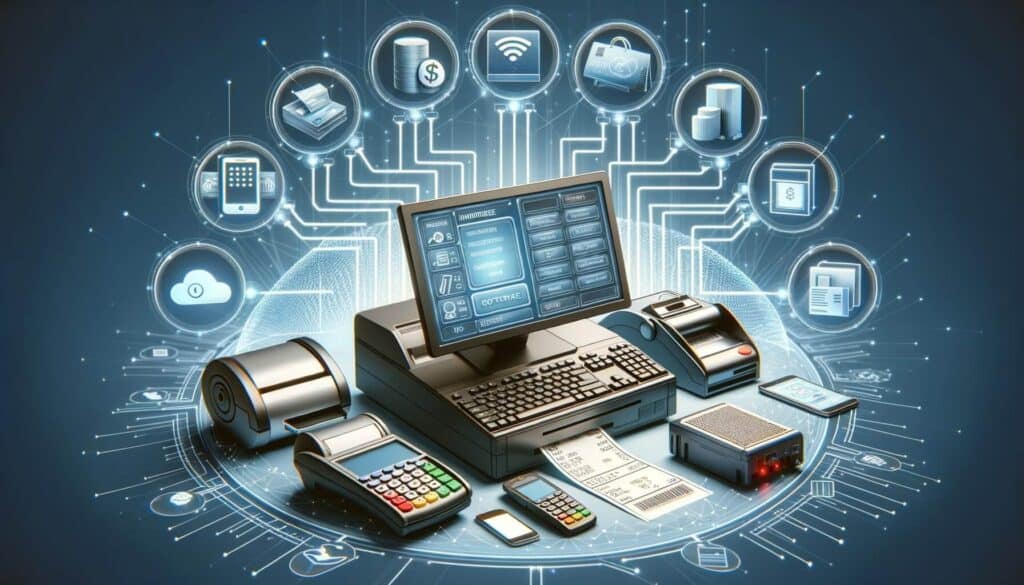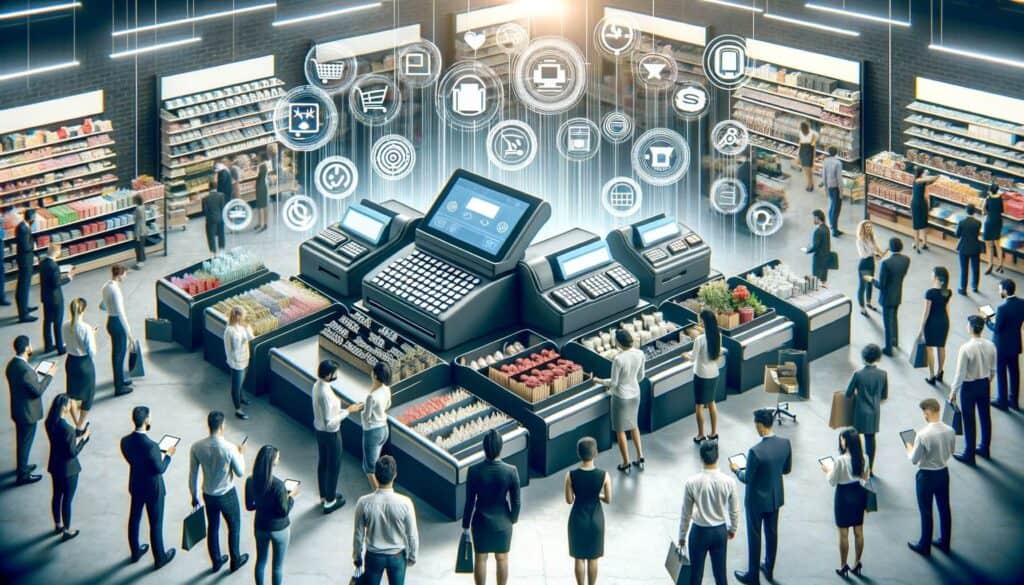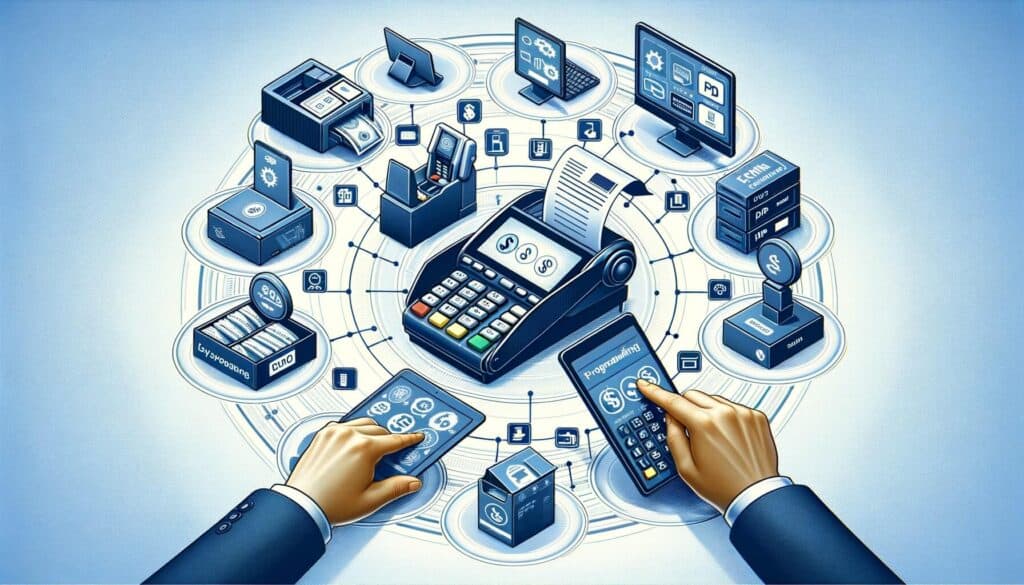
By Mollie Mills April 26, 2025
In today’s fast-paced business environment, efficiency and accuracy are crucial for success. One tool that has revolutionized the way businesses operate is the Point of Sale (POS) system. A POS system is a combination of hardware and software that allows businesses to process transactions, manage inventory, and track sales in real-time.
In this comprehensive guide, we will explore the basics of Point of Sale Systems, the key components, different types of systems, benefits of implementation, how to set up a Point of Sale System, essential features to look for, common challenges and solutions, and frequently asked questions.
Understanding the Basics: What is a Point of Sale System?
At its core, a POS system is a computerized system that enables businesses to complete sales transactions and manage various aspects of their operations. It typically consists of a computer or tablet, a cash register or barcode scanner, a receipt printer, and software that integrates all these components. The software allows businesses to process payments, track inventory, generate reports, and perform other essential functions.
Key Components of a POS (Point of Sale) System

A Point of Sale System comprises several key components that work together to streamline business operations. These components include hardware such as a computer or tablet, a cash register or barcode scanner, a receipt printer, and software that integrates all these components. Let’s take a closer look at each component:
1. Computer or Tablet: The central component of a Point of Sale System is a computer or tablet that serves as the main interface for the user. It runs the POS software and allows businesses to input and process sales transactions.
2. Cash Register or Barcode Scanner: A cash register or barcode scanner is used to scan and record the items being purchased. It helps in accurately calculating the total amount due and simplifies the checkout process.
3. Receipt Printer: A receipt printer is an essential component of a POS system as it allows businesses to provide customers with a printed record of their purchase. It can be either a thermal printer or an impact printer.
4. Software: The software is the brain of the Point of Sale System. It enables businesses to process payments, track inventory, generate reports, and perform other essential functions. The software can be cloud-based or installed locally on the computer or tablet.
Types of POS Systems: Choosing the Right One for Your Business

When it comes to choosing a Point of Sale System, businesses have several options to consider. The right POS system for your business will depend on factors such as the size of your business, the industry you operate in, and your specific needs. Here are the different types of Point of Sale Systems available:
1. Traditional POS Systems: Traditional Point of Sale Systems are typically installed locally on a computer or server. They require upfront hardware and software costs and are suitable for businesses with a fixed location and high transaction volumes.
2. Cloud-Based POS Systems: Cloud-based POS systems are becoming increasingly popular due to their flexibility and affordability. These systems operate on a subscription basis and store data in the cloud, allowing businesses to access their information from anywhere with an internet connection.
3. Mobile Point of Sale Systems: Mobile Point of Sale Systems are designed for businesses that require mobility, such as food trucks or pop-up shops. These systems run on tablets or smartphones and offer the convenience of accepting payments on the go.
Benefits of Implementing a Point of Sale System

Implementing a Point of Sale System offers numerous benefits for businesses of all sizes and industries. Let’s explore some of the key advantages:
1. Streamlined Operations: A POS system automates various tasks, such as inventory management, sales tracking, and reporting, which helps streamline business operations. This automation reduces the risk of human error and saves time, allowing employees to focus on more critical tasks.
2. Improved Efficiency: With a POS system, businesses can process transactions quickly and accurately. The system can calculate totals, apply discounts, and process payments in seconds, resulting in shorter wait times for customers and increased efficiency for the business.
3. Enhanced Inventory Management: A Point of Sale System provides real-time inventory tracking, allowing businesses to monitor stock levels, track sales trends, and automate reordering. This helps prevent stockouts, reduce overstocking, and optimize inventory levels, leading to cost savings and improved customer satisfaction.
4. Better Customer Insights: POS systems capture valuable customer data, such as purchase history and preferences. This information can be used to personalize marketing efforts, offer targeted promotions, and improve customer service, ultimately leading to increased customer loyalty and higher sales.
5. Accurate Reporting and Analytics: Point of Sale Systems generate detailed reports and analytics that provide businesses with valuable insights into their operations. These reports can include sales data, inventory turnover, employee performance, and more, helping businesses make informed decisions and identify areas for improvement.
How to Set Up a POS System: A Step-by-Step Guide

Setting up a POS system may seem daunting, but with the right approach, it can be a straightforward process. Here is a step-by-step guide to help you set up your Point of Sale System:
1. Assess Your Business Needs: Before choosing a Point of Sale System, assess your business needs and determine the features and functionality you require. Consider factors such as the size of your business, the number of locations, and the specific industry requirements.
2. Research and Compare POS Systems: Conduct thorough research and compare different POS systems available in the market. Look for systems that align with your business needs and budget. Consider factors such as ease of use, customer support, integration capabilities, and scalability.
3. Purchase the Necessary Hardware: Once you have chosen a Point of Sale System, purchase the necessary hardware components. This may include a computer or tablet, cash register or barcode scanner, receipt printer, and any other peripherals required by your chosen system.
4. Install and Set Up the Software: Install the POS software on your computer or tablet according to the instructions provided by the vendor. Set up the software by entering your business information, configuring tax settings, and adding products or services to your inventory.
5. Configure Payment Processing: Set up your payment processing options within the Point of Sale System. This may involve integrating with a payment gateway or setting up a merchant account. Ensure that your chosen POS system supports the payment methods you want to accept, such as credit cards, mobile payments, or cash.
6. Train Your Staff: Provide comprehensive training to your staff on how to use the POS system effectively. Familiarize them with the interface, teach them how to process transactions, handle returns, and perform other essential functions. Regularly update your staff on any software updates or new features.
7. Test and Troubleshoot: Before going live with your POS system, conduct thorough testing to ensure everything is functioning correctly. Test various scenarios, such as processing different types of transactions, applying discounts, and generating reports. Address any issues or glitches that arise during testing.
8. Go Live and Monitor Performance: Once you are confident in the functionality of your Point of Sale System, go live and start using it for your day-to-day operations. Monitor its performance closely and address any issues or concerns that arise promptly. Regularly review reports and analytics to gain insights into your business performance.
Essential Features to Look for in a POS System
When choosing a POS system, it is essential to consider the features and functionality it offers. Here are some essential features to look for:
1. Sales Processing: A good Point of Sale System should have robust sales processing capabilities, including the ability to process various payment methods, apply discounts, split payments, and handle returns or exchanges.
2. Inventory Management: Look for a Point of Sale System that offers comprehensive inventory management features. This includes real-time inventory tracking, automated reordering, stock alerts, and the ability to manage multiple locations or warehouses.
3. Reporting and Analytics: The POS system should provide detailed reports and analytics that give you insights into your business performance. Look for features such as sales reports, inventory turnover, employee performance tracking, and customer analytics.
4. Integration Capabilities: Consider the integration capabilities of the POS system. It should be able to integrate with other software or systems you use, such as accounting software, e-commerce platforms, or loyalty programs. This ensures seamless data flow and eliminates the need for manual data entry.
5. Scalability: Choose a POS system that can grow with your business. It should be able to handle increasing transaction volumes, support multiple locations, and accommodate additional features or modules as your business expands.
Common Challenges and Solutions in Using a POS System
While POS systems offer numerous benefits, they can also present challenges. Here are some common challenges businesses may face when using a POS system and their solutions:
1. Technical Issues: POS systems may encounter technical issues, such as software glitches or hardware malfunctions. To mitigate these issues, ensure you have reliable technical support from the POS system vendor. Regularly update your software and hardware to the latest versions and have backup systems in place.
2. Employee Training: Training employees on how to use the POS system effectively can be a challenge. Provide comprehensive training and ongoing support to ensure your staff is comfortable using the system. Consider creating training materials or conducting regular refresher sessions.
3. Data Security: Protecting customer data and ensuring data security is crucial. Choose a POS system that offers robust security features, such as encryption, user access controls, and regular data backups. Regularly update your system and educate your staff on best practices for data security.
4. Integration Issues: Integrating the POS system with other software or systems can sometimes be challenging. Ensure that the POS system you choose has integration capabilities and that the vendor provides support for integration. Work closely with your IT team or consultants to ensure a smooth integration process.
Frequently Asked Questions about POS Systems
Q1. What is the cost of a POS system?
Answer: The cost of a POS system can vary depending on factors such as the type of system, the number of hardware components required, and the software features. Traditional POS systems typically have higher upfront costs, while cloud-based systems operate on a subscription basis. It is essential to consider not only the initial cost but also any ongoing fees, such as software updates or technical support.
Q2. Can a POS system be customized to my business needs?
Answer: Yes, many POS systems offer customization options to tailor the system to your specific business needs. This may include customizing the user interface, adding or removing features, or integrating with other software or systems you use. Discuss your customization requirements with the POS system vendor to ensure they can meet your needs.
Q3. Can a POS system help with inventory management?
Answer: Yes, one of the key benefits of a POS system is its ability to streamline inventory management. A POS system can track inventory in real-time, automate reordering, generate stock alerts, and provide insights into sales trends. This helps businesses optimize their inventory levels, reduce stockouts, and improve overall inventory management.
Q4. Can a POS system handle multiple locations?
Answer: Yes, many POS systems can handle multiple locations or warehouses. This is particularly important for businesses with multiple stores or branches. Look for a POS system that offers centralized management, allowing you to monitor and manage inventory, sales, and other aspects of your business across all locations.
Conclusion
In conclusion, a POS system is a powerful tool that can revolutionize the way businesses operate. It streamlines operations, improves efficiency, enhances inventory management, provides valuable insights, and offers numerous other benefits. When choosing a POS system, consider factors such as your business needs, the type of system, essential features, and integration capabilities.
Follow a step-by-step guide to set up your POS system effectively, and address any challenges that may arise. With the right POS system in place, businesses can optimize their operations, provide better customer experiences, and drive growth and success.